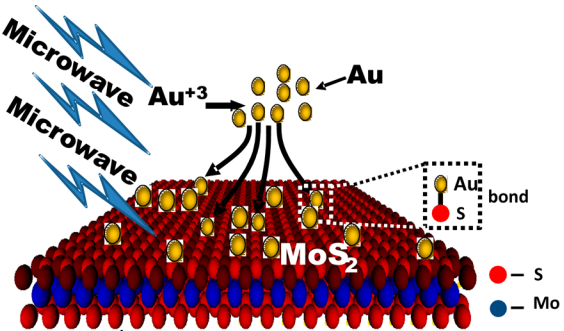Another breakthrough in replacing silicon in transistors
Promises to increase transistor performance, reduce size and heat
September 10, 2013

Anchoring
gold nanoparticles via microwave radiation on molybdenum disulfide
improves its electrical characteristics (credit: Kansas State
University)
The research may advance transistors, photodetectors, sensors and thermally conductive coatings, Berry said. It could also produce ultrafast, ultrathin logic and plasmonics devices.
Berry’s laboratory has been leading studies on synthesis and properties of several next-generation atomically thick nanomaterials, such as graphene and boron-nitride layers, which have been applied for sensitive detection, high-rectifying electronics, mechanically strong composites and novel bionanotechnology applications.
“These atomically thick structures have the potential to revolutionize electronics by evolving into devices that will be only a few atoms thick,” Berry said. They will also operate at lower voltages (and thus lower power and resulting lower heat dissipation), Berry explained to KurzweilAI.
The path to replacing silicon transistors
For the latest research, Berry and his team focused on transistors based on molybdenum disulfide (MoS2), which was isolated only two years ago. The material is made of three-atom-thick sheets and has recently shown to have transistor rectification that is better than graphene, which is a single-atom-thick sheet of carbon atoms.
When Berry’s team studied the MoS2 structure, they realized that the sulfur group on its surface had a strong chemistry with noble metals, including gold. By establishing a bond between MoS2 and gold nanostructures, they found that the bond acted as a highly coupled gate capacitor.
So Berry’s team manipulated MoS2 with gold nanomaterials, enhancing several transistor characteristics of MoS2, including reduced carrier-transport thermal-barrier and increased thermal conductivity.
As KurzweilAI recently reported, molybdenum disulfide may replace silicon CMOS transistors for future electronic devices or combine with graphene and hexagonal boron (as noted here and here) to form field-effect transistors, integrated logic circuits, photodetectors, and flexible optoelectronics. The Kansas State University research may further extend these developments by providing a route for direct electrode attachment on a molybdenum disulfide tunneling gate.
The work may greatly improve future electronics, which will be ultrathin, Berry said. The researchers have also developed a way to reduce the power required to operate these ultrathin devices.
“The research will pave the way for atomically fusing layered heterostructures to leverage their capacitive interactions for next-generation electronics and photonics,” Berry said. “For example, the gold nanoparticles can help launch 2-D plasmons on ultrathin materials, enabling their [use] for plasmonic-logic devices.”
The researchers plan to create further complex nanoscale architectures on molybdenum disulfide to build logic devices and sensors.
(¯`*• Global Source and/or more resources at http://goo.gl/zvSV7 │ www.Future-Observatory.blogspot.com and on LinkeIn Group's "Becoming Aware of the Futures" at http://goo.gl/8qKBbK │ @SciCzar │ Point of Contact: www.linkedin.com/in/AndresAgostini
 Washington
Washington